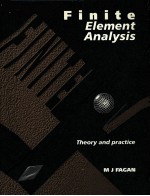

FINITE ELEMENT ANALYSIS THEORY AND PRACTICEPDF电子书下载
- 电子书积分:12 积分如何计算积分?
- 作 者:
- 出 版 社:LONGMAN SCIENTIFIC & TECHNICAL
- 出版年份:1992
- ISBN:
- 页数:316 页
1 Background and application 1
2 Introduction to the method 5
2.1 General theory 5
2.2 A simple one-dimensional element: the pin-jointed bar 6
2.2.1 Stress analysis of a stepped bar 9
2.3 A simple one-dimensional element: the thermal rod 12
2.3.1 Heat conduction through a wall 13
2.4 Conclusions 15
Problems 15
3 Discretization of the problem 19
3.1 Introduction 19
3.2 Geometrical approximations 19
3.3 Simplification through symmetry 20
3.4 Basic element shapes and behaviour 23
3.5 Choice of element type 25
3.6 Size and number of elements 29
3.7 Element shape and distortion 31
3.8 Location of nodes 33
3.9 Node and element numbering 34
3.10 Conclusions 37
Problems 38
4 Interpolation functions and simplex elements 39
4.1 Introduction 39
4.2 Simplex, complex and multiplex elements 41
4.3 Linear interpolation polynomials for simplex elements 43
4.4 Natural coordinates 49
4.5 Vector quantities 54
4.6 An axisymmetric element 56
4.7 Conclusions 57
Problems 57
5 Formulation of the element characteristic matrices and vectors for elasticity problems 61
5.1 Introduction 61
5.2 The variational formulation 61
5.3 One-dimensional elasticity 67
5.4 Two-dimensional elasticity 76
5.5 Three-dimensional elasticity 85
5.6 Axisymmetric elasticity 87
5.7 Conclusions 93
Problems 94
6 Formulation of the element characteristic matrices and vectors for field problems 101
6.1 Introduction 101
6.2 Formulation procedures 103
6.2.1 The variational formulation 103
6.2.2 The weighted residual method 106
6.2.3 Summary 109
6.3 Thermal problems 110
6.3.1 One-dimensional heat transfer 110
6.3.2 Two-dimensional heat transfer 123
6.3.3 Three-dimensional heat transfer 128
6.3.4 Axisymmetric heat transfer 130
6.4 Torsion problems 138
6.5 Fluid flow problems 146
6.6 Conclusions 146
Problems 148
7 Assembly and solution of the finite element equations 153
7.1 Introduction 153
7.2 Coordinate transformations 153
7.3 Assembly of the element equations 156
7.4 Incorporation of the boundary conditions 162
7.5 Solution of the equations 164
Problems 166
8 Higher-order element formulations 169
8.1 Introduction 169
8.2 Natural coordinate systems and numerical integration 171
8.3 Higher-order one-dimensional elements 174
8.3.1 Quadratic and cubic elements 174
8.3.2 Evaluation of the element equations 176
8.3.3 An alternative formulation 183
8.4 Higher-order two- and three-dimensional elements 185
8.4.1 Isoparametric triangular elements 185
8.4.2 Isoparametric quadrilateral elements 195
8.4.3 Isoparametric solid elements 201
8.4.4 Stress and heat flow calculations 203
8.5 Structural beam, plate and shell elements 203
8.6 Convergence requirements of interpolation functions 212
8.7 Conclusions 214
Problems 215
9 Modelling procedures and results processing 221
9.1 Introduction 221
9.2 Model validity and accuracy 221
9.3 Mesh design and refinement 230
9.4 Element distortion 239
9.5 Results processing 243
9.6 Model checking 245
10 Further applications of the finite element method 249
10.1 Introduction 249
10.2 Non-linear static elasticity problems 249
10.2.1 Material non-linearity 251
10.2.2 Geometric non-linearity 252
10.2.3 Combined material and geometric non-linearity 255
10.2.4 Non-linear contact conditions 256
10.3 Buckling problems 256
10.4 Dynamic problems 257
10.4.1 Modal analysis 258
10.4.2 Transient response analysis 259
10.4.3 Harmonic response analysis 262
10.4.4 Shock spectrum analysis 265
10.5 Transient thermal problems 267
11 Symmetry, submodelling and validation 269
11.1 Introduction 269
11.2 Symmetric models with non-symmetric loading 269
11.3 Submodelling and substructuring 275
11.4 Element and program validation 278
12 Commercial finite element programs 285
12.1 Introduction 285
12.2 General facilities 285
12.3 Pre-processors 287
12.3.1 Direct user input 287
12.3.2 Automatic mesh generation 293
12.4 Post-processors 295
Bibliography 297
Glossary 299
Index 311
- 《INITIAL REPORT OF CONTINENTAL SCIENTIFIC DRILLING PROJECT OF THE CRETACEOUS SONGLIAO BASIN(SK-1)》WANG CHENGSHAN WAN
- 《C++ AMP 用Visual C++加速大规模并行计算》(美)格雷戈里,(美)米勒著 2014
- 《税法》财政部注册会计师全国考试委员会办公室编 1996
- 《非线性量子力学》庞小峰编著 2009
- 《应用英语教程》宋宜贞主编 2009
- 《中国近代文学大系 1840-1919 第4集 第14卷 诗词集 1》钱仲联主编 1991
- 《中国近代文学大系 1840-1919 第3集 第11卷 散文集 2》任访秋主编 1992
- 《毛泽东传 1893-1949 上》中共中央文献研究室编;主编;金冲及 1996
- 《Visual Basic程序员的Java开发指南 用于Windows 95 & Windows NT》(美)(J.W.库珀)James W.Cooper著;于冬梅,宋勇译 1998
- 《二十世纪的历史学 从科学的客观性到后现代的挑战 from scientific objectivity to the postmodern challenge》(美)格奥尔格·伊格尔斯(Georg G. Iggers)著;何兆武译(山东大学文史哲编辑部) 2006
